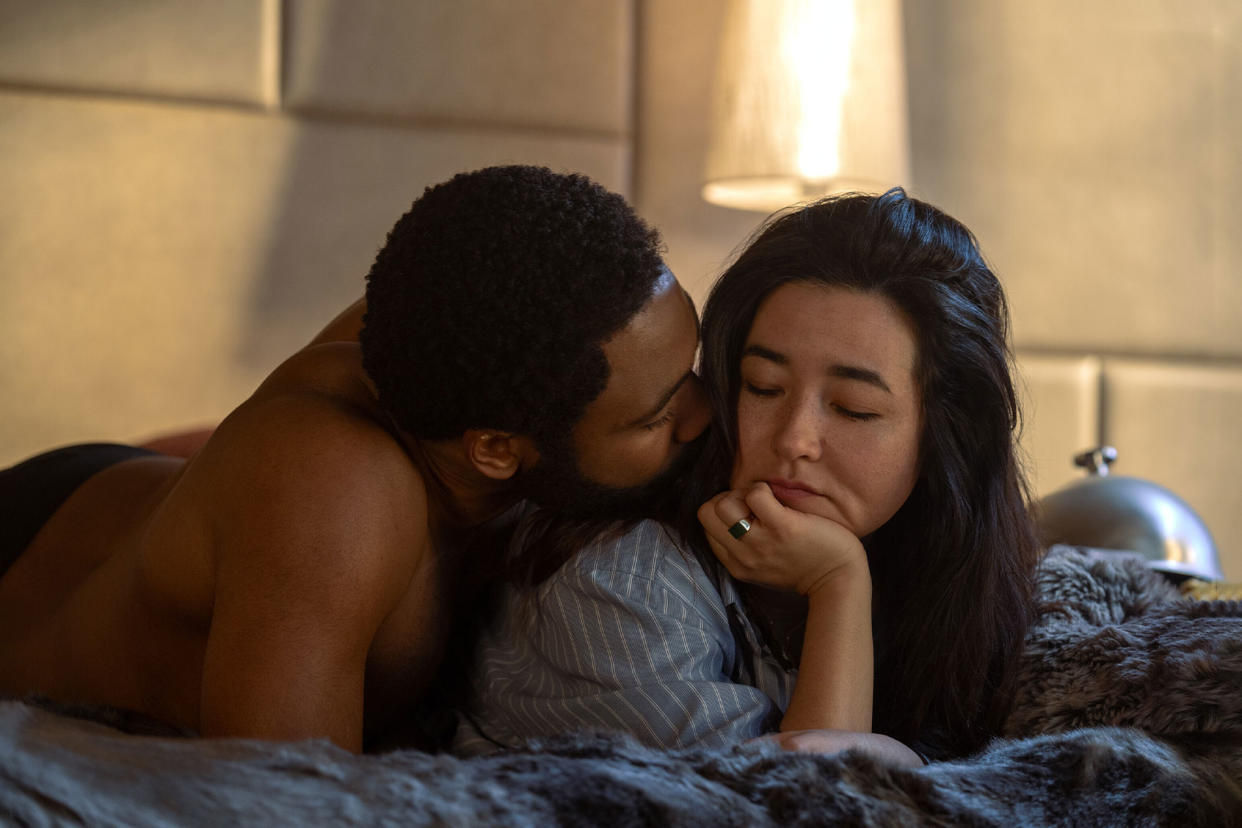"Mr. & Mrs. Smith" lands its mission to be an intimacy study. As an action comedy, it may be a miss

- Oops!Something went wrong.Please try again later.
How easy it is to forget that the first “Mr. and Mrs. Smith” drew us with the unspoken invitation to do a chemistry read. Otherwise, Doug Liman’s 2005 action comedy is a slight distraction – fun, but indistinct. Its main salvation was the casting of a meteoric, versatile screen talent from which stunning achievements were expected, and partnering her with Brad Pitt.
Its second grace was that Pitt and his wife Jennifer Aniston announced their separation months before the movie came out, confirming the tabloid rumors that he’d strayed with his co-star Angelina Jolie. Audiences flocked to this movie, making it a modest hit, less for the premise than out of a curiosity to see whether anything onscreen tipped off that these two were smashing.
Pitt and Jolie do spark onscreen. Upon closer examination, however, you may notice how much Liman relies on the audience to fill in the blanks. Maybe the issue is when we meet them they're trapped in a five- or six-year stale marriage that's a long way off from the day they stumbled into a hotel bar in Colombia, just one gorgeous person drawn to another. In the space of a handshake that lasts too long and some slo-mo dancefloor grinding, they’re in love. Neither realizes the other is an assassin for hire.
Or maybe it's because the script doesn't make much of an effort to build a sense that there was any closeness for these two to lose, whether through racy dialogue or sultry silence.
Prime Video’s eight-episode “Mr. and Mrs. Smith” doesn’t allow John (Donald Glover) and Jane Smith (Maya Erskine) to meet so cutely. They know they’re both spies when they lay eyes on each other for the first time at the New York apartment doubling as their HQ. What they don’t know is they’re also married.
John and Jane put that together when they dig into their welcome packet from the mysterious employer they call Hihi and discover rings and marriage certificates. Jane immediately decides that their union should be strictly for appearances, taking sex off the table. But success in the spy game is a matter of finding a balance between trust and distrust. We learned that through so many movies, making it a foregone conclusion that somehow these crazy kids must find a way to live and work together and eventually to care whether the other lives or dies.
The better John and Jane operate as a couple, the more effective they are as operatives.

But Glover and Erskine aren’t interested in contorting themselves to fit common expectations of what sexual heat should look like. Their approach is more ingenious, sending up tried and true movie methods of telegraphing burgeoning attraction and making us trust them without entirely believing.
Before a mission, for instance, John reaches out to brush a lock of Jane’s hair off her face – a standard rom-com move, along with her stammered reply that she’s not interested in anything sensual. He flatly responds that he’s merely trying to position her earpiece. Neither her sentiment nor his motivation is true. Not all of it is a lie, either. That uneasy energy steers “Mr. and Mrs. Smith” into slightly unconventional territory without successfully nailing enough notes to qualify it as a comedy.
A similar vibe permeates Glover’s recently ended “Atlanta,” on which he worked with this show’s co-creator and showrunner Francesca Sloane, but Glover’s FX series earned the audience’s faith in the artistic excursions undertaken in its second and third seasons by prioritizing laughter in its introductory run.
“Mr. and Mrs. Smith” feels more studied and aggressive in its effort to subvert expectations. That doesn’t mean it fails its mission but, rather, keeps making us ask what it is, exactly. It serves all the typical fare expected of action-forward movies and series, with at least one shoot-out, explosion or chase per episode.
John and Jane are a test case in exploring intimacy onscreen without the typical accelerants. They hit Italy twice in a short period and venture into the jungle once, getting bloody and battered each time. But there's nothing romantic about any of these trips. Even a grand gesture John makes at one point frustrates Jane. The story is gentler in floating an extended joke meant to normalize farting in the marriage bed. Efforts to bring the characters’ cultural differences into the story are more clumsily handled, to put it politely.
It’s an odd feeling to appreciate the show’s focus on the lighthearted banality of cohabitation over its gun fights and stranger still to notice the ways these choices shortchange the milestones that make us believe in cinematic relationships. Jane decides she cares about John only when she realizes death is on the table. Shortly after that, she leaps to the “L” word almost without giving us a reason to wonder why.
He kind of reciprocates. Maybe. But is this John holding his cards close to the vest or is Glover merely low-keying his way through this performance, as he's done in other shows?

There’s no denying that he and Erskine are a treat to watch – especially Erskine, who takes the gravelly voiced energy she channels through her voice work in “Blue Eye Samurai” and packs it into physically grueling, fight-for-your-life sequences between her slightly awkward interactions.
Want a daily wrap-up of all the news and commentary Salon has to offer? Subscribe to our morning newsletter, Crash Course.
Neither her Jane nor Glover’s John are operatives par excellence, which is where the farce creeps in. They dress well, but their moves are sloppy and unpolished, making gruesome choices in one moment and doing their best to keep from vomiting midway through that decision in the next. Most of their jobs end with us wondering whether they’ve succeeded or failed – but not for long, since Hihi lets them know. Stumbles are inevitable, but only a few times before measures must be taken.
The targets they meet along the way occasion cameos by famous actors, including Sharon Horgan, Ron Perlman, Michaela Coel and John Turturro, all of which serve to augment the pedigree of what Sloane and Glover are attempting.
One can’t help but think about the name that isn’t present: Phoebe Waller-Bridge, the series' original Jane Smith. In recent press appearances, Glover explained Waller-Bridge’s departure from the series as a matter of incompatible processes as opposed to hard feelings. Erskine’s eccentric style matches Glovers well enough – the underappreciated, brilliant “PEN15” wasn’t afraid to be more dramatic than comedic either.
Still, one wonders how much better this would be if its makers were more insistent on seducing the audience with humor instead of searching for ways to dance around it. This approach makes the TV version of “Mr. and Mrs. Smith” smarter than the movie, without question. But we didn’t flock to the original story for a brain teaser. Our assignment was to figure out if the thrill was worth all the trouble it caused. The same question is at the heart of this new marriage, and I’m not sure the answer at the end of “Mr. and Mrs. Smith” is worth sticking around to obtain.
All eight episodes of "Mr. and Mrs. Smith" are streaming on Prime Video.

